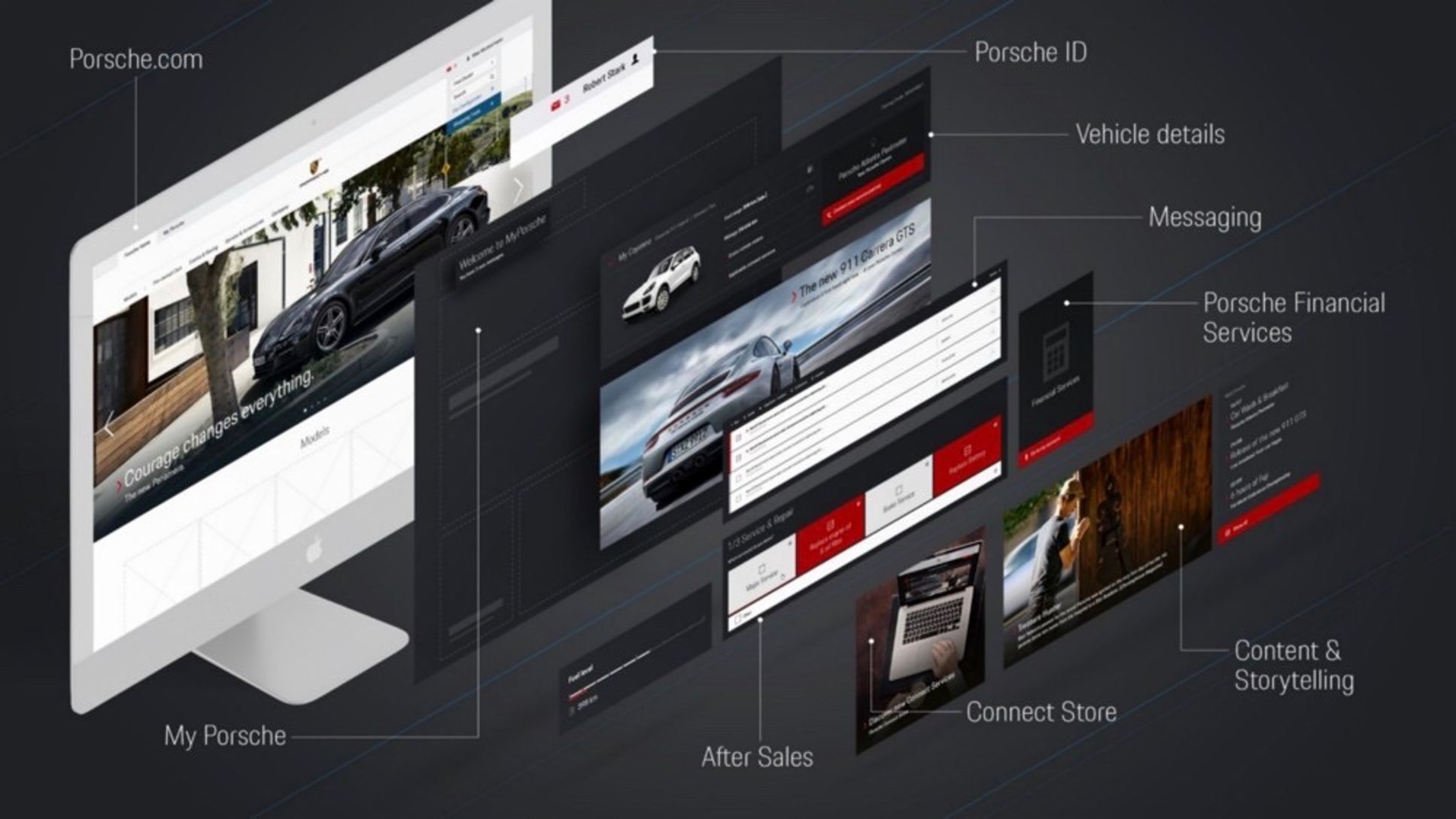The way that automotive customers interact with brands has changed, accompanied by a major transformation of customer needs and requirements. Today’s brand experience expands beyond the car and other offline touchpoints to include various digital touchpoints. Automotive customers expect a seamless brand experience across all channels — both offline and online.
One platform for every customer need: My Porsche
In order to meet these requirements, we brought My Porsche to life — a digital service platform for customers, fans, and enthusiasts that allows them to access exclusive content and take advantage of new functions and digital products and services. Users can for example check their vehicle status and schedule service appointments for their car, update their Porsche ID profile or chose their favorite Porsche Center.
At Porsche, currently, 17 product teams work on different features and modules for My Porsche, aiming to deliver a highly personalized customer experience across all touchpoints. A couple of years ago, Porsche realized that it was time to move My Porsche from Zuffenhausen-based servers into the cloud. In this post, we would like to take you with us on our My Porsche cloud journey. We are excited to share the unexpected difficulties and challenges as well as our learnings and insights of moving a customer portal into the cloud with you.
Getting Started: The My Porsche cloud journey
To begin with, why did we decide to move My Porsche to the cloud? The on-premise-to-cloud-infrastructure transition was motivated by two main factors:
Challenge #1: Worldwide presence without geo latency
Our cars are driven all over the world and the quality is the same everywhere. However, the My Porsche customer experience was not the same everywhere. Especially in locations far away from Zuffenhausen, it was far from optimal, since all services were hosted in Germany. As you can imagine, this resulted in performance issues and high loading times.
Challenge #2: Time to market
Our cloud ambitions were also motivated by the fact that we had to wait weeks to months for the provisioning of a server at that time, which most likely still was not fully ready by then: firewall, load balancers and more had each to be requested individually in ticketing systems and configured by specialized teams with long waiting times due to high load of those teams. Overall it took a lot of time — that was mainly spent waiting. And thus we needed a lot of time to generate business value.
Advantages of cloud computing: Fully automated infrastructure and dedicated control
Cloud computing offers many benefits. It can, for example, drastically improve performance and scalability, allowing us to improve customer satisfaction in every corner of the planet. This is due to many big cloud service providers offering data centers around the world. Another advantage of using the cloud is its self-service approach to consume cloud services via API: APIs provided by the cloud service providers allow a high level of automation, thus following the self-service approach that we strive for. In this combination we have been able to eliminate the waiting times, so we can commission a new server easily within seconds and at any given time. And in addition with repeatable same and high quality, e.g. configuration applied to the server. These kinds of offerings also make it possible for us to empower the teams by giving them their own space in the cloud, where they have full control over what happens. However, as we soon have learned, this newly gained control comes with new tasks and responsibilities.
Anyway, we were ready to kick-off the cloud journey. So let’s go!
On-premise to cloud migration gone wrong: Too much too soon
Securing a cloud provider was relatively easy. We chose AWS as a platform for our cloud infrastructure, and we have not regretted that decision once. The next step was to decide what applications and processes we needed to migrate. Particularly challenging was, e.g. secure access to the cloud, the new CI/CD systems, and the network design, i.e. how do the applications communicate with each other.
Together with our Cloud & Tools team, we started to build a blueprint, taking all the different aspects into account. And we thought we had a solid cloud migration strategy in place. Our plan was to finish this blueprint and roll it out across all teams — everything at the same time. So, we decided to go for it with a big bang! Back then, we thought that the transition process could not be that difficult. We said let’s do it. And we tried to move all of our teams to the cloud at the same time.
But that didn’t work out well.
After more than half a year, there was still not a single team in the cloud. We realized the migration process was not that easy after all and that there were many more unforeseen challenges to tackle than we thought.
The solution: Cloud deployment one step at a time
As a result, we updated our migration strategy. We said let’s focus and move only two teams at a time. We concentrated on a few key aspects: our edge component, Ping Access, and the vehicle-related services of the Portal Services team.
We sent two members from our Cloud & Tools team to each of the My Porsche teams. They would now be part of that team to follow two goals: achieve the go-live and, more importantly, empower and enable the team members. In parallel, they have finished the open parts of the blueprint. When the go-live had been achieved and enablement was completed, the My Porsche teams had to operate its applications and infrastructure on their own without the people from Cloud & Tools. This was something they didn’t have to worry about before — but new adventures bring new challenges with them.

Improved customer experience and internal collaboration: Check
Finally, two My Porsche teams had successfully moved to the cloud in April 2018. We continued with two teams at a time each with two people from Cloud & Tools. But we learned that we had to adapt. As time went on, new technologies came to replace old ones. But more importantly, we learned that every team is different. Each team we worked with had slightly different needs and requirements. Besides a technological transformation, our cloud journey also became a cultural journey.
Today, the My Porsche cloud adoption rate is at roughly 75 percent — and rising: we strive for a full 100 percent cloud coverage. 14 out of 17 teams have migrated to the cloud. The worldwide distribution of our applications has sped uploading time, improving the overall My Porsche customer experience. A huge success!
In our next post, we’ll talk about the importance of cross-functional, dedicated teams and the concept of decoupled alignment. Many thanks to everyone who has been part of the My Porsche Cloud journey so far!
Info
Text published by Adrian Föder, Solution Architect at Porsche AG and Marcus Voß, Product Owner My Porsche Cloud & Tools at Porsche AG.




